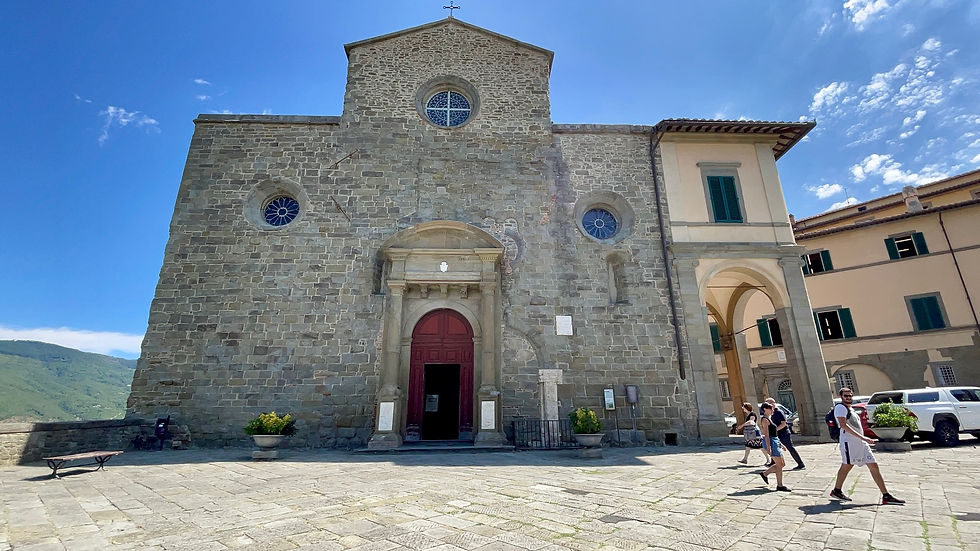Cortona is one of those quintessential Tuscan towns built into a hillside with mesmerizing views of the Valdichiana below. Like most of Tuscany's hill towns, you can visit Cortona for as long as time allows. For some that will be longer stays with overnight accommodations in the city center and for some, it will be a single-day trip experiencing the best of the city. Either way, each day is taken slowly so as to experience "La Dolce Far Niente" (loosely translated as the sweetness of doing nothing). A little investigating mixed with a lot of interactions with locals.
Getting There
While Cortona is on every American’s radar (if they have read or watched Under the Tuscan Sun), few know how hard it is to access the historic city center. You can definitely drive there. I’ve tried it before and it wasn’t fun. Think confusing street signs, hairpin turns, not much parking, and you still have to walk up hills and or steps before arriving. Of course, having a car and driver is always the preferred option. This way they can drop you off where you want and pick you up where you want. Always the perfect scenario for me. But if luxury travel isn’t an option, you can take a train to the Cortona-Camucia station and take the local bus up to Cortona. The bus is cheap (3 euros round trip) and drops you off at the top of town.
Taking the bus is a rewarding experience because of its final stop. Piazza Garibaldi offers some of the best views of the valley below Cortana. From here you can even see Lake Trasimeno in the distance. I always stay a while to enjoy the shade from the ancient trees, the constant cool breeze, and the scenery of course. Not far from the piazza is a late 15th-century church of San Domenico. Check to see if the doors are open. If they are, head in for a quick visit.
A Brief History Lesson
I know I say this often when it comes to describing Italy. But it can’t be helped – Italy is old. So is Cortona. It dates back over 3000 years. You can see a 400 B.C. well that was found when a shopkeeper decided to expand. Outside the city's walls (which themselves are originally 4th century B.C.) there is a monumental Etruscan tomb dating back to the first part of the 6th century B. C.
For more of Cortona’s exquisite collection of ancient artifacts as well as its detailed history visit the Museo dell’Accademia Etrusca at Piazza Signorelli, 9.
The city was a Roman colony and was completely decimated by the Goths in 450 A.D. And in the 12th century, history shows Cortona at war with neighboring Arezzo. You will find over the centuries - they did this a lot. The Casali family held power in the 15th century and the Medicis ruled in the 16th century. The Palazzo Casali now houses the Etruscan Museum previously mentioned.
The Duomo
You can find Cortona’s Cathedral located where else but the grand Piazza del Duomo. As with many churches in Italy, it was built over a Roman temple. The church is dedicated to the Assumption of the Virgin Mary. Little of the 11th-century structure remains. The vaulted ceiling is from the 18th century, the Pulpit from the 15th century and the terracotta Madonna is from the early 1400s.
The Cathedral bell tower is 16th century and the adjacent building with the loggia used to be the Bishop’s residence in the 14th – 16th century.
The Piazza del Duomo is not only a large area, it also has more great views of the Valdichiana below which houses the town’s cemetery. The piazza is also home to the Diocesan Museum (formerly the Church of Gesu) which displays art from some of Tuscany’s greatest masters: Fra Angelico, Signorelli, and Lorenzetti.
Via Janelli – Vicolo Iannelli
Not far from the duomo lies Via Janelli also known as Vicolo Iannelli. This street perfectly demonstrates how a city evolves from medieval times to the Renaissance. Here you find perfectly preserved 14th-century buildings made of stone. The first floors were added in the 16th century with bricks and original wooden posts that expanded the square footage of the upper floors.
Piazza della Repubblica
Be sure to stop in Cortona’s main square-Piazza della Repubblica. This piazza is home to the 13th-century Loggia della Pescheria and the even older 12th-century Palazzo del Comune with its clock tower. Grab a table at one of the piazza's cafes and people watch while you sip your beverage of choice. Sit here long enough to spot the local men playing cards as well as the nonna treating her grandchildren to an after-school snack.
The Best Part of Cortona
I always say the best way to know a location is to stay awhile-as long as you can. But if a day trip is all you have, then the second best way to know a location is to meet the locals. Cortona is an excellent place to do so. The Cortonese are the most hospitable people which makes this small town a favorite of most travelers.
Venture into any shop along the main drag- Via Nazionale or any side street and talk to the shopkeepers. Ask them about their products or about their building. Not only are they generous with their time, but they are also proud of their town. They will share as much about Cortona and the area as you are willing to hear. I can stay for hours and listen to their stories.
After your visit to Cortona, you’ll then understand why I go back again and again. Even if it’s just to enjoy a coffee or a spritz in a piazza or a great lunch in an authentic Tuscan restaurant.
You don't need much time to feel the emotions that others share when it comes to Cortona.





Comments